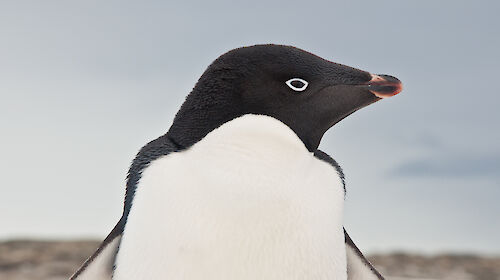Adélie penguin populations in East Antarctica have almost doubled over the past 30 years, according to research published in PLOS ONE today.
Australian Antarctic Division seabird ecologists, Dr Colin Southwell and Dr Louise Emmerson, alongside colleagues from Australia, France and Japan, found that the five main regional populations of Adélie penguins in East Antarctica have increased by 69 per cent since 1980.
The team used aerial photographs and ground-based observations to count Adélie penguins during recent summer breeding seasons at 99 sites located along 4500km of the East Antarctic coastline.
Dr Southwell said the counts were then compared with historical counts made at the same sites 30 years ago.
“Adélie penguins are top level predators that mainly eat krill and fish in the sea-ice zone, so the population increase likely reflects underlying changes in the lower levels of the food web and the sea-ice environment,” Dr Southwell said.
“Limited data on East Antarctic ecosystems makes it difficult to identify exactly how changing environmental conditions could have affected population growth, however, there are some possible explanations.
“Two aspects of the East Antarctic marine environment have changed over a large area and at a time that may be linked to the long-term population increase.
“Prior to current sustainable fishing practices, the harvesting of baleen whales, krill and fish across East Antarctic waters through the 20th century could have reduced competition between Adélie penguins and other predators for food, and improved prey availability.
“A proposed reduction in sea-ice extent in the mid-20 century may also have benefited Adélie penguins by enabling better access to the ocean for foraging.”
Dr Emmerson said the research showed a faster rate of population increase five years after periods when sea-ice cover in the winter foraging grounds decreased.
“This probably indicates that changes in winter sea-ice primarily affect young penguins before they become breeders at around five years old,” she said.
Despite the overall increase in the five regional populations (near stations at Dumont d’Urville, Casey, Davis, Mawson and Syowa), growth rates have varied. While most local populations have increased since 1980, some local populations have plateaued or decreased in recent years.
“This indicates that local processes – such as prey depletion or availability of breeding habitat at individual colonies — may affect population growth, in addition to regional processes such as reduced competition or sea-ice change,” Dr Emmerson said.
The population increase in East Antarctica contrasts strongly with research showing widespread decreases in Adélie penguin populations on the West Antarctic Peninsula over the same time.
“With Adélie penguins there is a delicate balance between too much and too little sea-ice for accessing foraging grounds, capturing prey and resting,” Dr Emmerson said.
“It has been proposed that in areas where ice is very extensive, such as East Antarctica, a reduction in sea ice extent will initially benefit the species up to a point, and then further reductions will be detrimental – as we are seeing in West Antarctica.”
The increasing Adélie population in East Antarctica also contrasts with declines in East Antarctic emperor penguin populations.
“Differing species’ ecologies can result in a range of responses to the same environmental conditions,” Dr Southwell said.
The research team said the future global status of Adélie penguins will depend on the complex interplay between the changing physical environment and the effects of human activities such as fishing and tourism.
“Further studies that look at penguin responses over space and time and also in different environments are critical for improving predictions of future changes in Adélie penguin populations,” Dr Emmerson said.
Fast facts
- Five species of penguins live on the Antarctic continent: the Adélie, emperor, gentoo, chinstrap and macaroni.
- Adélie penguins are top-level Antarctic predators that eat mainly Antarctic krill and fish.
- They are medium sized penguins, weighing 3–6 kg and standing 70 cm tall and are distinguished by the white ring surrounding the eye.
- Males and females are of similar size and difficult to tell apart visually.
- Adélie penguins breed around the entire coast and small islands of Antarctica, in places where there is exposed rock close to the ocean.
- Like all penguins, Adélies are excellent swimmers. They have been recorded travelling as far as 450 km away from their breeding sites to forage for food during the breeding season. They can dive to 140 m deep.
- They are also very determined long distance walkers, travelling up to 70km over sea-ice to reach their breeding sites even though their short legs restrict them to a waddling gait on land. Their walking speed on sea-ice averages 2.5 km/h and swimming speed from 4–8 km/h.
- Adélie penguins are a key indicator species for the Commission for the Conservation of Antarctic Marine Living Resources (CCAMLR) to detect impacts from krill fishery activities.




